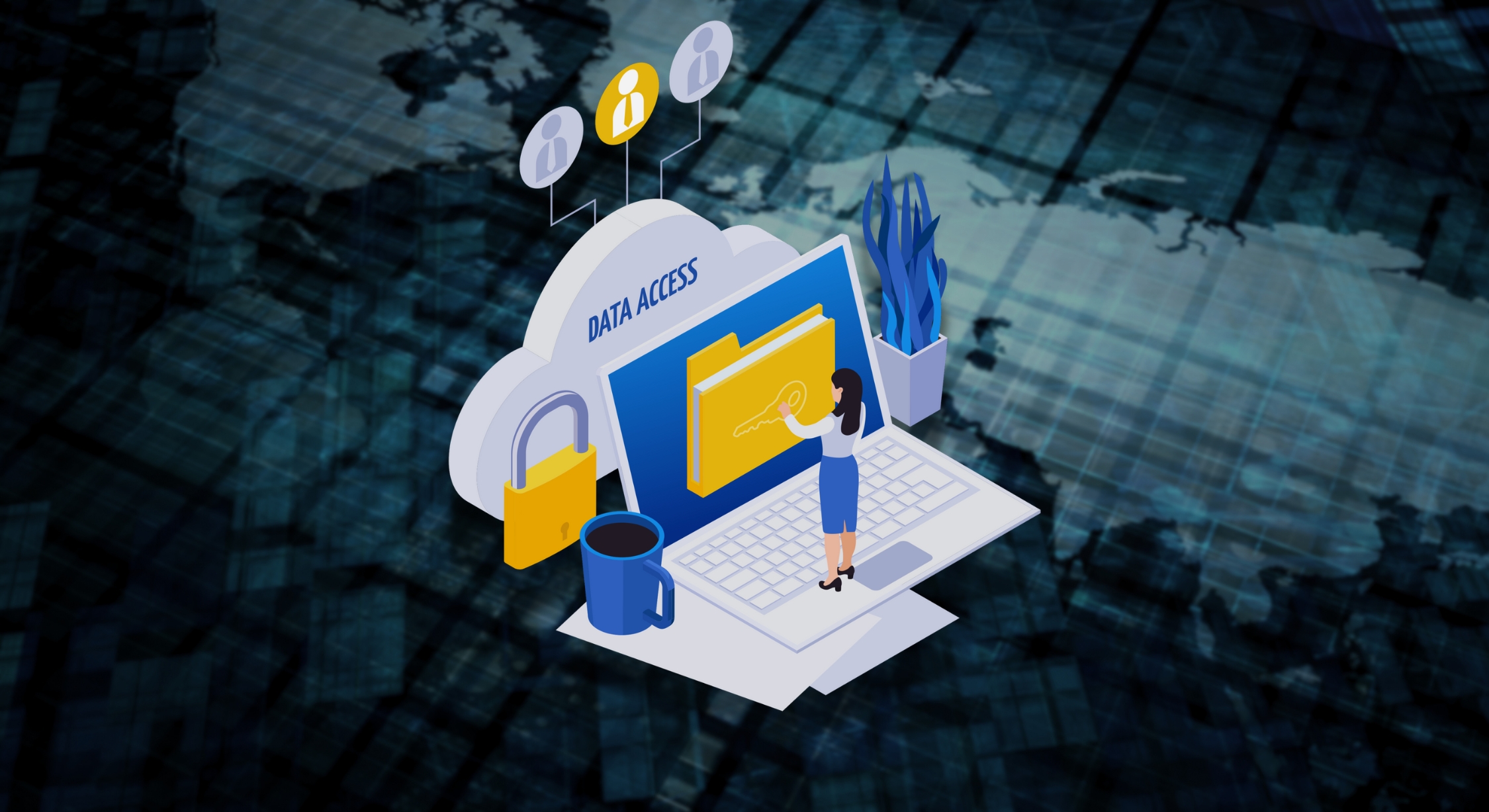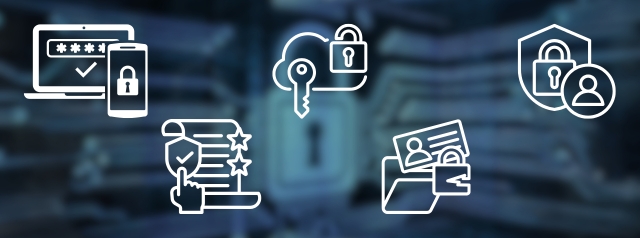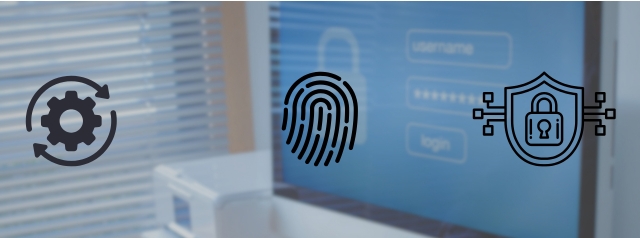Seamless access, uncompromised security. At Experion, we engineer IAM solutions that empower businesses to scale confidently while keeping threats at bay.
A single stolen password granting an outsider access to a company’s most sensitive financial records. Or an ex-employee still having access to critical systems months after leaving the organization. – These scenarios aren’t just hypotheticals. They happen all the time, and the consequences can be devastating.
As businesses operate in an increasingly digital world, managing who gets access to what, when, and how is no longer just an IT concern; it’s a fundamental business necessity. Identity and Access Management (IAM) software takes the guesswork out of access control, ensuring that employees, third-party vendors, and even automated systems only interact with the data and tools they are meant to. It’s not just about keeping hackers out; it’s about seamless, efficient, and secure access that enables business operations to run smoothly.
Understanding Identity and Access Management Software

Identity and Access Management (IAM) software, also referred to as identity management software or access management software, is a powerful suite of technologies designed to regulate and secure digital identities within an organization. It acts as a gatekeeper, ensuring that only authorized users can access specific systems, applications, or data.
IAM solutions are built around four key functions:
User provisioning ensures that new employees, customers, or third-party vendors receive the appropriate level of access upon onboarding. It allows organizations to automate account creation, manage permissions, and revoke access when necessary. Authentication verifies that users are who they claim to be through secure login methods such as passwords, biometrics, or multi-factor authentication. Authorization enforces access policies, ensuring that users can only interact with the systems, files, and applications relevant to their role. Auditing and compliance provide visibility into user activities, tracking access logs to detect anomalies and meet regulatory requirements.
For many organizations, a custom IAM solution is the preferred choice, allowing them to tailor security protocols to their unique operational needs and compliance requirements. By implementing IAM software, businesses gain a structured, automated approach to identity security, preventing unauthorized access and reducing risks associated with human error or insider threats.
Why Businesses Need Robust Identity and Access Management Software
The digital threat landscape is evolving at an alarming rate. From phishing attacks to insider threats, businesses face an ever-growing risk of cyber intrusions. IAM software is the frontline defense, protecting sensitive assets and maintaining business integrity.
Industries that handle large volumes of sensitive personal data, such as healthcare, finance, and retail, rely heavily on IAM solutions to ensure compliance and prevent unauthorized access. In healthcare, IAM software protects electronic health records (EHRs), ensuring that only authorized personnel can view or modify patient data. Financial institutions use IAM solutions to safeguard online banking services, preventing fraudulent transactions and identity theft. Retail and e-commerce businesses leverage IAM to secure customer accounts and payment processing, reducing the risk of data breaches and financial fraud.
With data privacy regulations like GDPR, HIPAA, and PCI-DSS imposing strict compliance requirements, IAM software provides businesses with the necessary access controls and audit trails to meet regulatory demands. Without a robust IAM framework, organizations risk hefty fines, reputational damage, and loss of customer trust due to security lapses.
The Role of Identity Management Software

A fundamental part of IAM strategy is identity management software, which ensures seamless and secure management of user identities throughout their lifecycle. From the moment an employee, vendor, or customer is granted access, their identity must be tracked, verified, and managed to prevent unauthorized activities.
This involves user provisioning and deprovisioning, which automates the creation and removal of user accounts based on employment status. Employees who leave the company or change roles automatically have their access adjusted to align with their new responsibilities. Password and credential management enforces strong authentication practices, reducing the risks associated with weak passwords or shared credentials. Directory services and access logs keep track of user activities, offering security teams real-time insights into potential threats or policy violations.
By integrating identity management software into the broader IAM framework, businesses can eliminate security loopholes, enhance user experience, and prevent identity-related threats before they happen. A well-structured identity management system ensures that every user interaction is verified and logged, making it easier to detect unauthorized access attempts and take proactive security measures.
Key Features of Identity Management Software
Effective identity management software isn’t just about keeping unauthorized users out—it’s about ensuring seamless, secure access for authorized individuals while maintaining organizational agility.
A centralized user identity management system stores and manages all user identities within an organization, eliminating the complexity of maintaining multiple credentials across different applications. This simplifies user administration, improves security, and ensures identity consistency across various platforms. For example, an enterprise with thousands of employees across multiple locations can instantly revoke access for departing employees, reducing security risks.
Multi-factor authentication (MFA) strengthens security by requiring multiple verification factors beyond just a password. Users may need to verify their identity using a one-time passcode (OTP), biometric authentication such as fingerprint scanning, or a security token. This extra security layer safeguards against unauthorized access, even if login credentials are compromised.
Role-based access controls (RBAC) ensure that employees only have access to the systems and data necessary for their job functions. Instead of granting blanket access, organizations can define roles and permissions, restricting access to critical resources based on a user’s position or department. This approach not only enhances security but also reduces the risk of accidental data exposure.
Benefits of Implementing Identity Management Software
- Seamless and Secure Access with Single Sign-On (SSO)
Managing multiple login credentials can be cumbersome and frustrating for employees. SSO simplifies access by allowing users to log in once and gain entry to all authorized applications and systems without needing to enter credentials repeatedly. This not only enhances convenience but also strengthens security by reducing the reliance on weak or repeated passwords. For organizations operating across multiple cloud platforms, SSO ensures a smooth and secure user experience without the risk of unauthorized access. - Enhanced Security with Multi-Factor Authentication (MFA)
Relying solely on passwords leaves organizations vulnerable to cyber threats such as phishing attacks and credential theft. Implementing MFA adds an additional layer of security by requiring users to verify their identity using multiple authentication factors such as biometric scans, security tokens, or one-time passcodes sent to registered devices. This significantly reduces the chances of unauthorized access, even if passwords are compromised, ensuring that only legitimate users gain entry. - Minimized Risk of Identity Fraud and Data Breaches
Unauthorized access to sensitive data can lead to financial losses, legal consequences, and reputational damage. Identity management software mitigates these risks by enforcing strict access controls, monitoring login activities, and instantly flagging suspicious behavior. Automated deprovisioning ensures that former employees or inactive accounts do not become security loopholes. By eliminating manual oversight errors and ensuring that only the right individuals have access, organizations significantly reduce their exposure to identity fraud and security breaches. - Role-Based Access Controls (RBAC) for Data Protection
One of the biggest security concerns for businesses is over-privileged users who have unnecessary access to critical data and applications. Role-based access controls ensure that employees only have access to the resources necessary for their roles. This minimizes the risk of data exposure, prevents accidental modifications to critical files, and ensures compliance with internal security policies. With predefined access policies, businesses can enforce a least-privilege approach, reducing the chances of internal threats and human errors leading to data leaks. - Increased Workforce Productivity and Efficiency
Employees lose valuable time navigating complex authentication procedures, waiting for access approvals, or recovering forgotten passwords. IAM solutions streamline these processes through automated identity provisioning, password self-service options, and faster access approvals. This allows employees to focus on core responsibilities instead of dealing with access-related delays. By integrating identity management software with HR and IT systems, businesses can further automate onboarding and offboarding processes, reducing manual workload and accelerating workforce productivity. - Compliance with Regulatory Standards and Audit Readiness
Organizations across industries must comply with stringent data protection regulations such as GDPR, HIPAA, PCI-DSS, and SOX. IAM solutions provide the necessary security frameworks to enforce compliance by tracking user access, maintaining audit logs, and ensuring data protection protocols are followed. Automated reporting tools generate real-time audit trails, making it easier for businesses to prove compliance during regulatory inspections. By proactively managing access controls and authentication policies, organizations can avoid hefty penalties and legal consequences tied to non-compliance. - Improved Customer and Partner Access Management
Businesses dealing with multiple stakeholders, including customers, vendors, and partners, need a secure yet flexible way to manage external access. IAM software enables secure authentication for third parties while ensuring that external users have limited access to internal systems. Features such as adaptive authentication and federated identity management provide secure access to business applications without exposing critical infrastructure to unauthorized users. This enhances security while fostering smooth collaboration with partners and improving the overall customer experience. - Scalability to Support Business Growth
As organizations expand, their security needs become more complex. Identity management software is designed to scale with business growth, ensuring seamless access management across an increasing number of employees, applications, and locations. Whether a business is integrating new cloud-based applications, onboarding a remote workforce, or entering new markets, IAM solutions can adapt without compromising security. Scalability ensures that companies can future-proof their security infrastructure while maintaining operational agility.
Exploring Access Management Software
Have you ever wondered what would happen if an employee, whether accidentally or with intent, accessed critical financial data they weren’t supposed to? Or if a former contractor’s account was never deactivated and got exploited by hackers? These are real-world risks that businesses face daily. Access management software steps in to prevent such scenarios by ensuring that only the right people, at the right time, with the right permissions, can access sensitive systems and data.
Access management is no longer just about logging in with a username and password. In an era of sophisticated cyber threats, businesses need dynamic, context-aware security solutions that can assess risk in real time. A recent study by Verizon found that 61% of data breaches involve stolen or weak credentials, making it essential for businesses to have strong access controls in place. With well-designed access management, organizations can detect unusual behavior, enforce security policies, and stop unauthorized access before it becomes a problem.
Core Functions of Access Management Software
Imagine a large enterprise with multiple departments, third-party vendors, and a hybrid workforce spread across different regions. Managing who gets access to what can quickly become a logistical nightmare. Access management software simplifies this by enforcing strict policies and monitoring access behavior.
- Defining and enforcing access control policies: Should a junior finance employee have access to all accounting records? Should a marketing intern be able to view sensitive customer data? Without clear access policies, security gaps arise. By implementing role-based access control (RBAC) or attribute-based access control (ABAC), businesses can ensure that users only access what they need for their job.
- Real-time monitoring and auditing: Security teams can’t afford to wait until a breach happens to take action. Access management software continuously tracks login attempts, location-based access, and suspicious patterns. For example, if an employee who normally logs in from New York suddenly tries to access systems from a foreign IP address, the system can flag it as a risk and either request additional authentication or block the attempt altogether.
Enhancing Security with Access Management Software
What if your security system could learn and adapt? What if it could detect risk before a breach even happens? This is where AI-driven access management comes in.
- Using AI and machine learning for smarter access decisions: Traditional security systems rely on predefined rules, but AI-based solutions analyze user behavior, login history, and device patterns to spot irregularities. If a user suddenly attempts to access restricted files at an unusual time, AI can trigger an additional authentication request or even lock the session. According to Gartner, by 2025, AI-driven security systems will autonomously handle 75% of access requests—reducing human intervention while improving accuracy.
- Dynamic permissions and Just-in-Time (JIT) access: How long should an employee retain access to sensitive resources? Most businesses grant permanent permissions, which can be a major security risk. Instead, JIT access grants temporary permissions for a limited period—ensuring users only have access while they actually need it. A finance department employee working on an audit, for instance, might need access to restricted reports for a single day rather than permanent access. After that period, their permissions automatically expire, reducing security risks significantly.
Custom Identity and Access Management Software: Tailored Solutions for Unique Needs

Most businesses start with off-the-shelf IAM solutions, but sooner or later, they run into limitations. What if your security policies require unique authentication workflows? What if your existing tools don’t integrate well with a generic IAM solution? This is where custom identity and access management software becomes invaluable.
Why Opt for Custom IAM Software?
- Because one-size-fits-all doesn’t always fit: A hospital and a financial institution both deal with sensitive data, but their security needs are completely different. A custom IAM solution allows businesses to design access policies that align with industry-specific regulations like HIPAA for healthcare or PCI-DSS for finance.
- Because businesses rely on legacy systems: Many companies still use custom-built applications that don’t easily integrate with modern IAM platforms. Custom IAM solutions ensure seamless connectivity across cloud services, legacy applications, and third-party tools, eliminating security blind spots. A 2022 report from Forrester found that 74% of enterprises face integration challenges when implementing IAM solutions, highlighting the need for customization.
Developing Custom IAM Solutions: Key Considerations
- How scalable is your IAM system? Right now, your company might have 500 employees. What happens when you grow to 5,000? Will your IAM solution scale with you? A well-designed custom IAM system should accommodate future growth by supporting multi-cloud access, federated authentication, and global user management without requiring frequent reconfigurations.
- Does security slow down your employees? Security should never feel like an obstacle. If employees find it frustrating to access the tools they need, they’ll find workarounds -potentially exposing the company to security risks. Custom IAM solutions prioritize usability, offering features like single sign-on (SSO), biometric authentication, and self-service password resets to keep security seamless and frictionless.
- How quickly can you adapt to new security threats? Cyber threats evolve rapidly, and businesses need IAM systems that can keep up. A custom-built IAM solution can integrate AI-driven threat detection, adaptive authentication, and real-time risk scoring to prevent breaches before they happen. Research from IBM shows that companies with advanced IAM systems contain security threats 27% faster than those relying on outdated methods.
Why settle for standard security when you can have intelligent security? Experion’s IAM solutions integrate AI, automation, and analytics to transform the way businesses control access.
Implementing and Managing Identity and Access Management Solutions (IAM Solutions) Effectively
Deploying an IAM solution is not just about installing software and enforcing policies; it’s about integrating security seamlessly into daily operations while maintaining a smooth user experience. The most common mistakes in IAM implementation come from rushed deployments, poor user adoption, and failing to anticipate future security needs. To avoid these pitfalls, businesses must strategically implement, continuously monitor, and proactively manage their IAM frameworks.
Best Practices for Deploying IAM Solutions
- Phased Approach
Rolling out an IAM solution across an entire organization in one go can create disruptions and resistance from employees. A phased approach ensures a smoother transition by first securing the most critical systems such as financial databases, customer records, and executive access before gradually expanding IAM implementation to other areas. This minimizes operational risks and allows for course corrections before full deployment.
- Comprehensive Planning
Before deployment, businesses should clearly define security goals, map user roles, and identify high-risk access points. IAM is not a one-size-fits-all solution; different departments have different security needs. For example, IT admins require elevated access to system configurations, while HR personnel may only need limited access to employee records. Analyzing these requirements beforehand ensures policies align with business needs rather than creating unnecessary restrictions.
- User Training and Education
Even the most advanced IAM solution is ineffective if users don’t understand how to use it. A major cause of security breaches is human error, such as employees falling for phishing scams or mismanaging credentials. Training sessions should cover:
- How to use multi-factor authentication (MFA) effectively.
- Recognizing and avoiding social engineering attacks.
- Best practices for managing passwords and access permissions.
- A well-trained workforce strengthens IAM security, reducing the risk of accidental insider threats.
Continuous Improvement: Adapting IAM to Changing Threats
Cybersecurity is never static. New attack techniques emerge daily, and businesses must ensure that their IAM solutions evolve just as quickly. Continuous improvement requires proactive monitoring, regular security assessments, and quick adaptability to stay ahead of threats.
Regular Security Audits and Access Reviews: Many organizations make the mistake of granting permanent access to employees who no longer need specific privileges. IAM systems should include automated access reviews that periodically reassess whether users still require access to certain systems. A recent Ponemon Institute study found that 63% of data breaches stem from excessive access privileges—highlighting the importance of regular permissions auditing.
Automated Threat Detection and Adaptive Security: AI-powered IAM solutions can detect unusual login behaviors, unauthorized access attempts, and potential identity theft in real time. For instance, if a user logs in from an unrecognized location and device, IAM software can flag the activity, trigger multi-factor authentication, or temporarily block access until the login is verified.
Vulnerability Patching and Compliance Updates: Compliance regulations such as GDPR, HIPAA, and CCPA require organizations to follow strict security guidelines. IAM solutions should be continuously updated to ensure compliance with these regulations while also patching vulnerabilities that could be exploited by attackers.
The Future of Identity and Access Management Software

As digital ecosystems become more complex, IAM is undergoing radical transformations to keep up with new security challenges and technologies. The future of IAM will be defined by automation, decentralized identity solutions, and integration with Zero Trust security frameworks.
Emerging Trends in IAM
Decentralized Identity Systems
The traditional approach to IAM involves storing user credentials in centralized databases, making them prime targets for cyberattacks. Decentralized identity solutions powered by blockchain and self-sovereign identity (SSI) models shift control back to users, reducing reliance on central databases and improving security.
Advancements in Biometric Authentication
Passwords are becoming obsolete, with companies moving toward biometric authentication methods like facial recognition, iris scanning, and behavioral biometrics. These authentication methods significantly reduce the risks of stolen credentials while providing a more seamless login experience. A study by Juniper Research predicts that biometric authentication will be used in over 1.4 billion devices by 2025, reinforcing its role in future IAM solutions.
IAM’s Role in a Zero Trust Security Model
Cyber threats no longer come solely from outside an organization. Insider threats, compromised accounts, and supply chain attacks pose just as much risk. The Zero Trust security model operates under the principle of “never trust, always verify”, requiring continuous authentication and strict access controls. IAM solutions are the foundation of this model by:
- Enforcing Multi-Factor Authentication (MFA) on All Access Points: Users must verify their identities through multiple steps before gaining access, making unauthorized entry significantly harder for attackers.
- Applying Least Privilege Access :I AM ensures that users only get access to what they need, for as long as they need it, reducing the risk of insider threats or credential misuse.
Monitoring and Risk-Based Authentication: IAM software constantly monitors user behavior and applies adaptive authentication based on risk level. If an account suddenly starts behaving suspiciously like logging in from an unfamiliar IP or attempting to access sensitive data, it triggers additional security measures like re-authentication or session termination.
Conclusion
IAM solutions don’t just secure digital environments; they also streamline operations, enhance user experiences, and ensure compliance with global security regulations. Whether it’s through adaptive authentication, biometric security, or AI-driven access monitoring, IAM technology is rapidly advancing to meet the challenges of an increasingly digital world.
To stay ahead, businesses must adopt advanced IAM solutions that go beyond basic authentication. Where off-the-shelf IAM tools fall short, custom identity and access management software can provide tailored security frameworks that align with industry regulations, organizational needs, and future-proof security strategies.
Cyber threats won’t wait. The future of digital identity is here, and Experion is leading the way. From seamless authentication to airtight access control, we help businesses stay ahead in an evolving cyber landscape.

